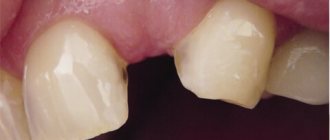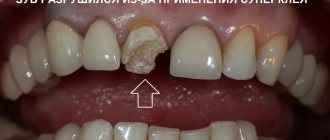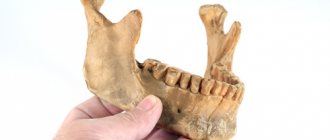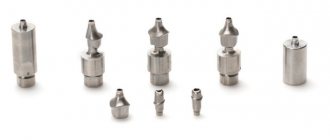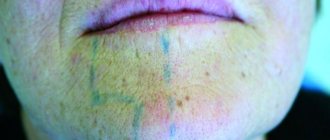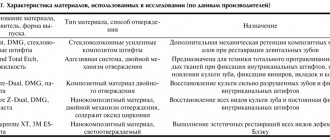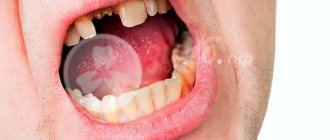Number of roots in human teeth
There can only be one dental crown, but the number of roots a tooth has depends on its location and purpose. The number of roots is also influenced by hereditary factors. It is possible to determine how many roots a tooth has only with the help of an x-ray. The inner part of the tooth (root) makes up about 70% of the entire tooth.
Factors influencing the number of roots:
- Location of the tooth.
- The purpose of the tooth, its functionality (chewing or frontal).
- Genetic predisposition.
- Patient's age and race. In the European race, the number of dental roots is very different from the Negroid and Mongoloid races.
Should I get dentures for the 7th tooth?
This question, oddly enough, cannot be called rarely asked. This is probably due to the fact that the “seventh” teeth can be classified as practically the most distant ones and their absence is not noticeable to people around them in everyday life. However, this is by no means the main purpose of teeth - it is the distant chewing teeth that play one of the key roles in the process of chewing food, on which the quality of digestion largely depends. And already, at least based on this, it is undoubtedly better to perform dental prosthetics.
However, let’s try to answer this question based on several extremely important aspects:
- If at least one chewing tooth is missing in the jaw, then the chewing load can no longer be distributed evenly, which means that sooner or later, problems with other teeth will inevitably begin;
- Our body is a perfect mechanism in which everything is interdependent and interconnected. This also applies to teeth: one of the features of our jaw is that the antagonist tooth (the tooth that is located clearly opposite in the upper/lower jaw) will be subject to the possibility of loss after a certain period of time. Since it no longer has support, it will begin to move forward, become loose, and may fall out;
- Digestive problems due to insufficient chewing of food are a very common case in people whose jaws lack the teeth necessary for chewing food.
These are, perhaps, the main factors that prove that dental prosthetics , which we need for chewing food, is a necessity for the health of the oral cavity and the body as a whole.
The main ways by which prosthetics can be made for “seventh” teeth in their absence are:
- Prosthetics with a bridge. This scheme is possible if you have adjacent teeth preserved in your mouth - that is, the sixth and eighth. They will serve as a support for the prosthesis. The disadvantage of the described prosthetic option is the need to grind down these very adjacent teeth - this cannot be avoided, since it is impossible to secure the prosthesis (bridge) otherwise;
- Dental implantation. Implantation of an artificial tooth root is the most progressive method of prosthetics for tooth loss and does not in any way affect neighboring teeth. After the implants have taken root, a crown .
It should be noted that dental implantation for prosthetics of the “seventh” tooth will be the most effective, harmless to other teeth, durable and reliable option. This is due to the fact that the service life of bridges is, on average, several years. While implants, if all recommendations are followed and proper oral care is taken, can last for the rest of your life.
Share on social media networks:
Rating 0.00 [0 Vote(s)]
Teeth numbering system
Dentists have developed a system in which all teeth have their own serial number. The numbering system for the teeth of the lower and upper rows will not allow you to “get confused” in the teeth.
The first number is the incisors - the frontal teeth of the upper and lower rows. There are two teeth on each side (left and right): No. 1 - central, No. 2 - lateral, behind which there are fangs, numbered No. 3. The small molars have numbers 4 and 5.
All of the listed teeth have one cone-shaped root.
Teeth No. 6, 7, 8 - large molars have three roots, and tooth No. 6 of the lower row has one root, with the exception of tooth No. 8, which can have 3 or even 4 roots.
Is it possible to place a crown right away?
A one-stage technique with instant loading involves the rapid restoration of lost teeth - the titanium root is loaded with a temporary crown for a maximum of 3 days after surgery. But this method is only suitable for replacing teeth that do not take part in chewing (premolars - fours, fives).
This method is not recommended for second molars. When eating, the sevens are subject to stress, which leads to displacement of the implant. Therefore, the crown is installed after healing, when the root has firmly grown into the bone. Until osseointegration is completed, the patient wears a lightweight removable denture. It is attached to adjacent teeth and does not load the implant. If the patient insists on immediate installation of a crown, the clinic does not provide a guarantee for the implant system.
If the patient insists on immediate installation of a crown, the clinic does not provide a guarantee for the implant system.
How many canals are there in teeth?
The number of tooth canals does not always coincide with the number of roots. The number of channels can only be determined using x-rays. The upper incisors usually have two or three canals. Some teeth have only one canal, which branches into two parts.
Number of canals in teeth:
- Upper Lower four – 1, less often 2 channels;
- Upper second – 1, less often 2 and even 3 channels;
- Bottom five – one channel;
- Upper first molar 3, 4 canals;
- Lower first molar – 3, less often 2 canals;
- Upper and lower seven – 3, 4 channels.
Getting ready to install the tab
The next step was to level the distal wall of the adjacent sixth tooth - this must be done so that the inlay fits evenly.
We scanned the area and began to create a beautiful inlay using CEREC technology, under the bite, we chose the A4 color:
The patient had very dark teeth, so I moved the inlay lower down the block when turning it on the router.
CEREC machined the inlay in high quality extra fine mode, that is, in high precision mode and with 4 burs. The production time in this case is 25 minutes. It turned out super beautiful and super accurate - you can see it in the photos:
The process of making inlays using CEREC technology fascinates patients. And in this case, our patient, of course, observed this process.
The option of the tab in extra fine quality looks perfectly beautiful. We checked the connections - the tab “sat” on the seventh chewing tooth, according to the patient, like a native one. We have good contact points. Installing the inlay took the patient very little time; they met the “tooth in 1 hour” standard. The patient was very pleased.
Author:
Sergey Samsakov
orthopedic dentist
born 02/02/1989
Education:
2011 — Graduated from the Moscow State Medical and Dental University named after. A.I.Evdokimova
2012 — Internship in the specialty “Orthopedic Dentistry”, Moscow State Medical University named after. A.I.Evdokimova
2014 - Residency in Orthopedic Dentistry, Moscow State Medical University named after. A.I.Evdokimova
Viola system
Members of the International Dental Association adopted a dental identification system in 1971, giving it the name Viola. It describes a tooth with two numbers and is extremely common among doctors all over the world. In this system, the jaw is divided in half, with four segments each having 8 teeth. Each segment is designated from 1 to 4.
A tooth has a two-digit designation, the first digit indicates the corresponding segment. The second number is the number of the tooth in the jaw, from its middle. There are 32 teeth in total, and the second digit can be from 1 to 8. The segments (first digit) are as follows:
- upper jaw on the right - No. 1;
- top left - No. 2;
- bottom left - No. 3;
- bottom right - No. 4.
Milk teeth are designated differently. When they have erupted in the child, below are the rudiments of permanent ones, taken into account by the Viola system. Therefore, to describe primary teeth, segments are given numbers from 5 to 8. Segments are numbered clockwise. The second digit can be from 1 to 5, since there are 20 primary teeth.
The simple Viola system is extremely popular among dentists.
The classic method of installing sevens implants
A two-stage protocol involves introducing a two-part titanium root into the bone (separate intraosseous and external parts) using a patchwork method, waiting for its engraftment, followed by prosthetics. The classic method is implemented when there is a sufficient amount of bone tissue. If the alveolar ridge in the area of the former seven is significantly atrophied, osteoplasty operations are resorted to. The bone is built up with artificial material, implants are installed simultaneously or after the material has engrafted.
Pros and cons of the classical method:
| Advantages | Flaws |
| extensive experience in implantology; | long implementation periods; |
| predicted result; | wearing removable dentures for the period of osseointegration; |
| formation of a beautiful gingival contour; | the need to build up bone when it is insufficient. |
| possibility of using implants from various manufacturers; | |
| the ability to eliminate defects in a row of any length. |
In appropriate clinical situations, it is possible to use other treatment regimens—simultaneous or single-stage implantation.
Price
- Primary appointment (examination, consultation) with a dentist (special offer) 100001
For free
Promotion
- Dental prosthetics using an implant with a temporary crown using the laboratory method (PMMA) 152006
7 500 ₽
- Simple tooth extraction 160001
1 900 ₽
- SGS implant + turnkey crown
24 900 ₽
Promotion
- Osstem implant + turnkey zirconium crown
29 900 ₽
Promotion
- Astra Tech implant + turnkey zirconium crown
59 900 ₽
Promotion
- Nobel implant + turnkey zirconium crown
59 900 ₽
Promotion
- Straumann implant + turnkey zirconium crown
59 900 ₽
Promotion
Implantation of the seventh tooth involves inserting an implant into the jaw and fixing an artificial crown on it. The method ensures complete restoration of the functions of the seven, but is associated with some risks. This is a surgical operation, with preparation and a rehabilitation period of 3-4 months. To replace the 7th lower or upper tooth, a classic two-stage treatment protocol is suitable, the implementation of which may require bone tissue augmentation. If the protocol is followed correctly, the patient will receive a tooth that matches the natural one.
Features on the upper and lower jaw
The areas of the masticatory apparatus are exposed to varying degrees of stress and have some anatomical features. Hence the difference in bone density and volume, as well as the possibilities of row restoration.
Implantation of the 7th upper tooth
Restoring the top seven poses some challenges. The upper jaw bone is less voluminous than the lower jaw. Due to the reduced loads, it is less dense and undergoes atrophy more quickly after the loss of its own teeth. The implant for replacing the seven is located near the maxillary sinus, infraorbital foramina, and nerves, which increases the risk of complications in case of unsatisfactory stability.
To avoid adverse consequences due to lack of bone tissue, it is recommended to perform a sinus lift. The intervention involves increasing the height of the jaw bone by raising the bottom of the maxillary sinus. The operation is performed simultaneously with the installation of implants or separately using a closed or open technique. It all depends on the initial volume of bone tissue.
Implantation of the 7th lower tooth
The lower jaw is constantly exposed to high loads during chewing. This promotes compaction of bone tissue. After the loss of the lower sevens, the alveolar ridge atrophies slowly, so osteoplasty in this area is rarely performed. If the tooth has been lost for a long time, extensions may be required. For the mandibular bone, the following methods are used:
- replanting of bone material with the installation of barrier membranes - performed after tooth extraction or simultaneously with the introduction of titanium roots;
- splitting the alveolar ridge - involves cutting the process and introducing bone material into the hole in order to increase the thickness of the bone;
- bone autotransplantation - a piece of the patient’s bone, taken from another place, is transplanted into the area of the seven.
Bone density provides high primary stability, which reduces the risk of complications. However, large loads on the lower molars do not allow prosthetics to be performed immediately after installation of a titanium rod.
Are you planning to restore a tooth with a CEREC inlay?
Always at your service - Sergey Samsakov, orthopedic dentist with more than 10 years of successful experience, Moscow. Expert in 3D digital smile modeling, dental inlays and dental modules, veneers and digital CEREC technology.
Patients come to me from all over Russia:
Extraction for acute and chronic inflammation
Quite often, the removal of a problematic tooth is accompanied by the presence of purulent foci, gum inflammation or periodontitis. In such cases, the doctor prescribes intensive therapy with the use of antibacterial drugs, and only after the inflammatory process has been suppressed is surgery to remove the tooth performed.
There are also situations when a tooth needs to be removed urgently. Only an experienced, highly qualified doctor can perform surgery in such cases.

